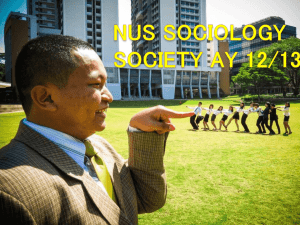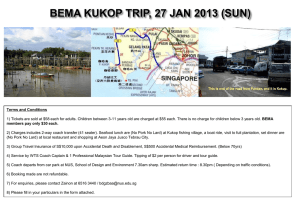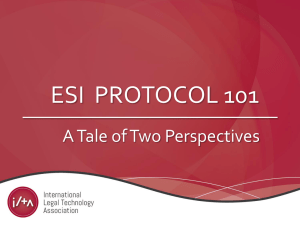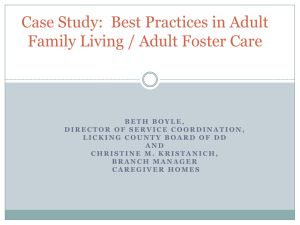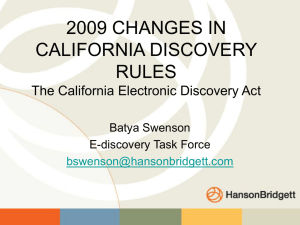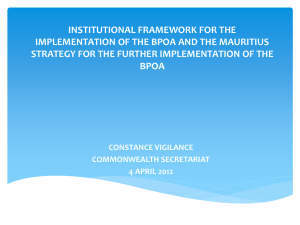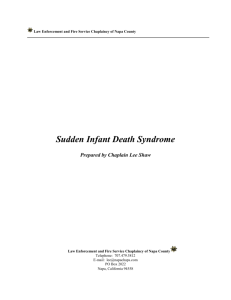Energy Security in Singapore
advertisement
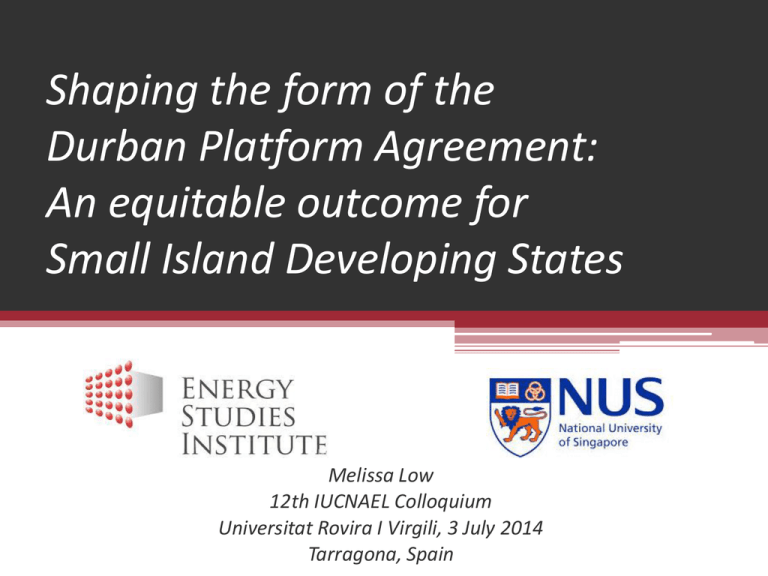
Shaping the form of the Durban Platform Agreement: An equitable outcome for Small Island Developing States Melissa Low 12th IUCNAEL Colloquium Universitat Rovira I Virgili, 3 July 2014 Tarragona, Spain Melissa Low, ESI NUS Year of Small Island Developing States • Disproportionate vulnerability to the adverse effects of climate change, especially sea level rise • Eclectic group of countries, formally recognized as a group in various international environmental fora • How should the 2015 agreement reflect the vulnerabilities and circumstances of SIDS? 2 3 SIDS within the negotiating groups of the UNFCCC (Source: UNFCCC, 2005) Melissa Low, ESI NUS The Durban Platform Mandate In 2011, the expiration of the first commitment period of the Kyoto Protocol was imminent. Thus, the UNFCCC at its seventeenth session (COP17) in Durban initiated a new process called the Ad hoc Working Group on the Durban Platform for Enhanced Action (ADP) to ‘adopt a protocol, another legal instrument or an agreed outcome with legal force under the Convention applicable to all Parties’ 4 5 Melissa Low, ESI NUS Options for Legal form for the 2015 Climate Agreement ‘a Protocol… under the Convention’ ‘another legal instrument… under the Convention’ ‘agreed outcome with legal force… under the Convention’ A protocol Amendments (Art 15) Does not limit the result to one instrument Annexes (Art 16) Amendments to annexes (Art 16) Could also be interpreted as legal instruments embodied in domestic, rather than international law COP decisions A Protocol would not only have to recognize mitigation pledges as a means to reduce GHG emissions and prevent catastrophic climate change and ensure the very survival of SIDS, it would also have to include adaptation and the slow onset of loss and damage over time. Source: Voight, 2012 Melissa Low, ESI NUS Source: Lavanya Rjamani presentation on “Differential Treatment in International Environmental Law”, Workshop on scope, structure and design of the 2015 agreement, ADP 2-1, 29 April 2013, Bonn Germany 6 Melissa Low, ESI NUS Reasons for a Protocol 1. Applicable to all Parties 2. Strengthens the ‘rules-based… regime under the Convention’ 3. Strengthens the ‘multi-lateral… regime under the Convention’ 4. Many commitments of Annex I Parties of the Kyoto Protocol to a second commitment period (CP2) is conditioned upon a comprehensive new agreement (‘part of the package’) 5. Timeline between adoption in 2015 and coming into effect and being implemented from 2020 is reminiscent of a process for ratification 6. For COP decisions to have a normative (‘regulatory’) effect, the COP needs to be empowered by treaty law to adopt decisions of binding nature. 7 Melissa Low, ESI NUS Options other than a Protocol 1. Amendment 2. Annex(es) 3. Amendment to Annex(es) 4. ‘Package outcome’ of both a legally-binding instrument and COP decisions of various types 5. Legal instruments embodied in domestic, rather than international law 8 Melissa Low, ESI NUS SIDS & Legally Binding Agreements • SIDS have a history of pursuing legally binding agreements (Drumbl, 2000, Tulane Law Review) ▫ In response to the international community’s preference to enter into negotiating processes that ultimately end in soft law agreements with little commitment to action (Fry, 2005, Review of European, Comparative & International Law • Slow progress could be tolerated if SIDS were generally convinced that this would lead to legal bindingness in the end (Ramlogan, 2002, Vermont Journal of the Environment), or the belief that accumulative enunciation of their concerns and aspirations made by numerous non-binding texts my help express the opinio juris of the world community (Dupuy, 1991, Michigan Journal of International Law) 9 Melissa Low, ESI NUS 10 SIDS & AOSIS • SIDS have been able to obtain some remarkable achievements in the climate change negotiations by building a cohesive coalition, the Alliance of Small Island States (AOSIS) • AOSIS has a membership of 44 States and observers, from all oceans and regions of the world: Africa, Caribbean, Indian Ocean, Mediterranean, Pacific and South China Sea ▫ 37 are members of the UN, 20% of total UN membership ▫ Form nearly 28% of developing countries ▫ 5% of global population • Not always easy to find a common denominator among 44 member countries • As the UNFCCC process increases in scope and complexity, different and potentially divergent interests are likely to become more pronounced (Betzold et al, 2013, Climate Policy) 11 Increased complexity of negotiation dynamic since 1995: Number of Parties, regional and coalition Groups e.g. EU, AOSIS, G77 & China. More recently African Group, Alliance of Latin American and Caribbean Countries (AILAC), Environmental Integrity Group, Umbrella Group etc. Parties compelled by national policies, avoid locking into commitments restrictive to growth means that concessions will need to be made towards the 2015 Agreement . (Source: Betzold et al, 2012, adapted from Castro et al, 2011) 12 Singapore • • • • • • • Urban city-state of just 715.8km² (50km W-E X 26km N-S) Tropical climate on equator Low-lying, gentle topography, highest point 164m Population: 5.40 million in June 2013 Population density: 7, 540 persons per km² GDP: S$372.813 billion in 2013 Per capita GDP: S$69,050 in 2013 (Ranked 1st in 2012 Knight Frank & Citi Wealth Report ) • Contribution to global emissions: 43,454 ktCO2, less than 0.2% • Per capita emissions: 12.49 tCO2/person in 2011 (Ranked 15th in 2011 by WRI CAIT 2.0) Source: NEA, Singapore in Figures 2013, Photo by Yousef Al Habshi 13 Source: The Straits Times, 29 June 2014 14 Perspectives from an island city-State • No rewriting of the Convention • Universal Participation • National Circumstances • Nationally Determined Actions • Balanced Package Dr Vivian Balakrishnan, Singapore’s Minister for Environment and Water Resources delivering the National Statement at the highlevel segment at COP19 in Warsaw on 20th Nov 2014. ADP Co-Chairs Kishan Kumarsingh and Artur RungeMetzger in conversation Singapore’s Environment Minister, Dr Vivian Balakrishnan and Chief Negotiator, Amb Burhan Gafoor 15 Intense ADP discussions on text Source: IISD/ENB, Dr Vivian Balakrishnan Facebook Page Singapore’s Chief Negotiator with China’s Chief Negotiator, Su Wei Minister Balakrishan chairing a Ministerial Dialogue on the 2015 Agreement with New Zealand’s Tim Groser Melissa Low, ESI NUS Rules of the Game • Climate effectiveness • Legal form of Agreement/Protocol • Frequency of reviews • Robustness of a transparency framework 16 Melissa Low, ESI NUS What should the 2015 Climate Agreement reflect, do for SIDS? Understand the diversity of locally designed responses to CC, and provide recognition of such action ▫ System of recognition ▫ Access to support for implementation Facilitation of interaction of UNFCCC process with SIDS ▫ Engage further on means and impacts of coordinating and facilitating action ▫ Recognizing diversity of governance approaches in cities ▫ Provide platform for practitioners to directly interact and share experiences Support implementation ▫ Enhancing the Barbados Programme of Action to catalyze development of climate action goals by SIDS without current targets or goals, and enhance existing ones 17 Melissa Low, ESI NUS Concluding notes • Legal form of the 2015 Climate Agreement is far from settled • Clear that a Protocol can provide the most equitable outcome for SIDS, given that all Parties will need to commit to emissions reductions • However, options other than a Protocol exist and the negotiations will likely explore all of them before Paris, 2015 • Case study of Singapore highlights diversity of views from SIDS • Apart from legal form, the 2015 Climate Agreement must have an enhanced structure to engage small island developing states through ▫ Recognition of action ▫ Facilitation of interaction ▫ Supporting implementation 18 Melissa Low, ESI NUS Thank you! Energy Studies Institute 29 Heng Mui Keng Terrace Block A, #10-01 Singapore 119620 Melissa Low Tel: (65) 6516 3080 Email: esimlyx@nus.edu.sg 19


